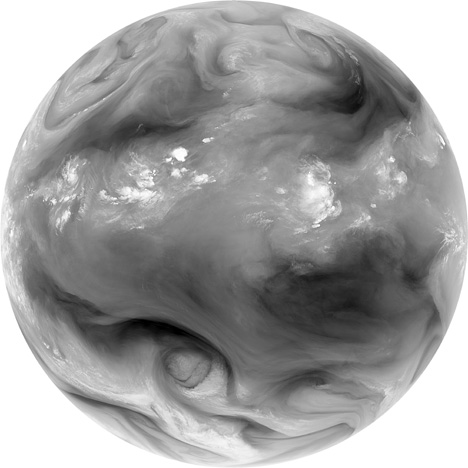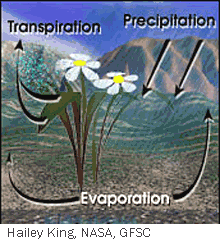
|
||||||||||||
|
|
|
Water Vapor : the number one greenhouse gas
August 2011 Water vapor is water in its gaseous state-instead of liquid or solid (ice). Water vapor is totally invisible. If you see a cloud, fog, or mist, these are all liquid water, not water vapor.
Water vapor—and with it energy—is carried around the globe by weather systems. This satellite image shows the distribution of water vapor over Africa and the Atlantic Ocean. White areas have high concentrations of water vapor, while dark regions are relatively dry. The brightest white areas are towering thunderclouds. The image was acquired on the morning of September 2, 2010 by SEVIRI aboard METEOSAT-9. (Image ©2010 EUMETSAT.) WATER VAPOR:Water is a unique substance. It can exist as a liquid, solid (ice), and gas (water vapor). A primary way water vapor increases in the atmosphere is through evaporation. Liquid water evaporates from oceans, lakes, rivers, plants, the ground, and fallen rain. A lot or a little water vapor can be present in the air. Winds in the atmosphere then transport the water vapor from one place to another. Most of the water vapor in the atmosphere is contained within the first 10,000 feet or so above the earth's surface. Water vapor also is called moisture. ABSOLUTE HUMIDITY:Absolute humidity (expressed as grams of water vapor per cubic meter volume of air) is a measure of the actual amount of water vapor (moisture) in the air, regardless of the air's temperature. The higher the amount of water vapor, the higher the absolute humidity. For example, a maximum of about 30 grams of water vapor can exist in a cubic meter volume of air with a temperature in the middle 80s. SPECIFIC HUMIDITY refers to the weight (amount) of water vapor contained in a unit weight (amount) of air (expressed as grams of water vapor per kilogram of air). Absolute and specific humidity are quite similar in concept. RELATIVE HUMIDITY:Relative humidity (RH) (expressed as a percent) also measures water vapor, but RELATIVE to the temperature of the air. In other words, it is a measure of the actual amount of water vapor in the air compared to the total amount of vapor that can exist in the air at its current temperature. Warm air can possess more water vapor (moisture) than cold air, so with the same amount of absolute/specific humidity, air will have a HIGHER relative humidity if the air is cooler, and a LOWER relative humidity if the air is warmer. What we "feel" outside is the actual amount of moisture (absolute humidity) in the air. DEWPOINT:Meteorologists routinely consider the "dewpoint" temperature (instead of, but analogous to absolute humidity) to evaluate moisture, especially in the spring and summer. The dewpoint temperature, which provides a measure of the actual amount of water vapor in the air, is the temperature to which the air must be cooled in order for that air to be saturated. Although weather conditions affect people differently, in general in the spring and summer, surface dewpoint temperatures in the 50s usually are comfortable to most people, in the 60s are somewhat uncomfortable (humid), and in the 70s are quite uncomfortable (very humid). In the Ohio Valley (including Kentucky), common dewpoints during the summer range from the middle 60s to middle 70s. Dewpoints as high as 80 or the lower 80s have been recorded, which is very oppressive but fortunately relatively rare. While dewpoint gives one a quick idea of moisture content in the air, relative humidity does not since the humidity is relative to the air temperature. In other words, relative humidity cannot be determined from knowing the dewpoint alone, the actual air temperature must also be known. If the air is totally saturated at a particular level (e.g., the surface), then the dewpoint temperature is the same as the actual air temperature, and the relative humidity is 100 percent. Water vapor is added to the atmosphere by two primary natural mechanisms:
Transpiration - Plants take in water in their root systems and release it into the atmosphere through their leaves. Evaporation - Water is converted to vapor phase from the ground or a body of water and mixes with the atmosphere. Evaporation accounts for approximately 90% of water vapor, and transpiration accounts for 10% of water vapor.
Water vapor is a natural and very important component of the Earth’s atmosphere. Its distribution influences many physical and chemical properties of the atmosphere, including weather, clouds, precipitation, lightning generation, convective uplift, and the Antarctic ozone hole. Water is constantly cycling through the atmosphere. Water evaporates from the Earth’s surface and rises on warm updrafts into the atmosphere. It condenses into clouds, is blown by the wind, and then falls back to the Earth as rain or snow. This cycle is one important way that heat and energy are transferred from the surface of the Earth to the atmosphere, and transported from one place to another on our planet.
The water vapor image show an infrared band which is affected strongly by the presence of water vapor. Essentially, the image shows the altitude of the highest moist layer in the atmosphere. Bright areas reflect the location of high clouds either due to jet stream cloudiness or due to thunderstorm activity. The dark areas reflect the location of dry air at high altitudes. This is associated with dry air intrusion and sinking motion associated with high pressure systems. This image is a decent tracer of jet stream winds which will show up as bright streaks. Water vapor is also the most important greenhouse gas in the atmosphere. Heat radiated from Earth’s surface is absorbed by water vapor molecules in the lower atmosphere. The water vapor molecules, in turn, radiate heat in all directions. Some of the heat returns to the Earth’'s surface. Thus, water vapor is a second source of warmth (in addition to sunlight) at the Earth’s surface. Despite its importance to atmospheric processes over a wide range of spatial and temporal scales, water vapor is one of the least understood and poorly described components of the earth's atmosphere.
As the temperature of the atmosphere rises, more water is evaporated from ground storage (rivers, oceans, reservoirs, soil). Because the air is warmer, the absolute humidity can be higher (in essence, the air is able to 'hold' more water when it's warmer), leading to more water vapor in the atmosphere. As a greenhouse gas, the higher concentration of water vapor is then able to absorb more thermal IR energy radiated from the Earth, thus further warming the atmosphere. The warmer atmosphere can then hold more water vapor and so on and so on. This is referred to as a 'positive feedback loop'. As water vapor increases in the atmosphere, more of it will eventually also condense into clouds, which are more able to reflect incoming solar radiation (thus allowing less energy to reach the Earth's surface and heat it up). Water vapor accounts for the largest percentage of the greenhouse effect. The major greenhouse gases are:
Water Vapor Confirmed as Major Player in Climate Change
11.17.08
Water vapor is known to be
Earth’s most abundant greenhouse gas, but the extent of its contribution
to global warming has been debated. Using recent NASA satellite data,
researchers have estimated more precisely than ever the heat-trapping
effect of water in the air, validating the role of the gas as a critical
component of climate change.
Credit:Kathryn Hansen NASA's Goddard Space Flight Center
|








